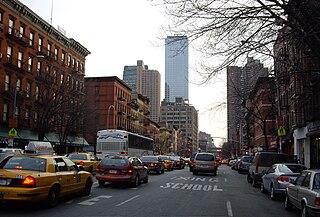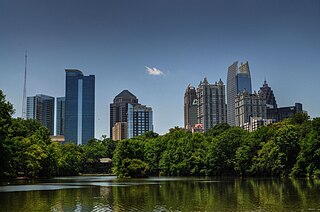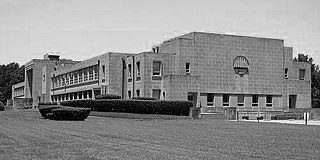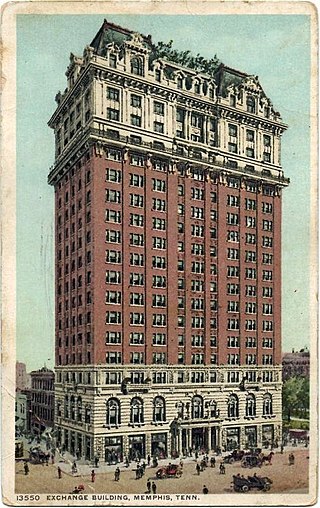
Central Gardens is a historic Memphis neighborhood in Midtown.

Central Gardens is a historic Memphis neighborhood in Midtown.
Central Gardens is bound by York Avenue on the south, Eastmoreland Avenue on the north, Rembert Street on the east, and Cleveland Street on the west. [1]
Listed on the National Register of Historic Places, Central Gardens was built primarily between 1850 and 1930 and originally served as home to the city's wealthy middle-class residents who moved east during the heyday of the cotton boom [2] along with the expanding city limits, which by 1900 shifted to East Parkway in what is now Midtown. [3] Originally part of the estate of Solomon Rozelle, who had settled in Shelby County in 1815 on 1,600 acres of then wooded wilderness, the land that became Central Gardens was inherited by Rozelle's children upon his death in 1840, according to historian Barbara B. Viser. [4] Records from 1853 document that C. W. Rozelle owned 30 acres of what became Central Gardens. Also in 1853, Judge William Roland Harris bought 40 acres from B. L. Rozelle and built his home, Clanlo Hall, on what is now Central Avenue. Clanlo and the Rozelle House on Harbert Avenue, both c. 1853, were the only two homes in the neighborhood at the time. They are the oldest homes in Central Gardens. [4] Unlike the nearby Annesdale neighborhood, which was created as a smaller, single subdivision, Central Gardens is made up of several subdivisions, such as Merriman Park, the Harbert Place subdivision, Bonnie Crest, as well as several large estates that were subdivided. [3]
Viser identifies 1900-1929 as the "boom years" for Central Gardens, the period in which it was "the newest, most prestigious neighborhood" in Memphis, with homes ranging from "elegant mansions to Queen Anne cottages and cozy bungalows." Streetcars provided convenient transportation to downtown Memphis. [5]
Central Gardens has been home to Mayor E. H. Crump, [6] Clarence Saunders, [7] Mayor Walter Chandler, [8] Memphis grocer Frank Montesi Sr., [9] photographer William Eggleston, [9] Judge Julia Smith Gibbons, [10] U.S. Representative Steve Cohen, [10] entrepreneur Abe Plough, preservationist June West, and Crissy Haslam, wife of Tennessee governor Bill Haslam. [11]

Grace-St. Luke's Episcopal Church (constructed in 1912 [12] ) and the Catholic Cathedral of the Immaculate Conception (1938) are located in Central Gardens. Both the church and the cathedral have adjoining schools. [13] Central Christian Church, located at the corner of South McLean since 1924, is part of the Christian Church (Disciples of Christ) denomination. [14]
Grace-St. Luke's Episcopal School, a coeducational parish day school established in 1947, serves over 500 students in PK - 8th grade. Known as GSL, the school is located at the corner of Belvedere Boulevard and Peabody Avenue. [15]
Immaculate Conception Cathedral School, located on Central Avenue, is a coeducational elementary school and an all-girls college preparatory high school. [16] Idlewild Elementary School is part of the Memphis City Schools system. [17]
Just outside Central Gardens is Central High School, a public high school (grades 9-12) in Memphis, Tennessee. It was founded in 1897 and is considered the first high school in Memphis; Central is often called "THE" High School. It is a part of the Memphis City Schools Optional School system where it is recognized as a school specializing in college preparatory programs. Central High's building is on the List of Registered Historic Places in Tennessee. [18]
From 1955 until 2001, [19] the main library of the Memphis Public Library System was located in Central Gardens at the corner of Peabody and South McLean. [20]
Central Gardens, composed of approximately 83 blocks, 1,540 structures and 511 acres (2.07 km2) in Midtown Memphis, has an architectural style that is highly eclectic. It reflects the prevailing tastes among early twentieth century middle class Memphians, and the best in urban residential community planning and architecture of that period. The wide variety of architectural styles works well because of uniform setbacks, cornice heights and massing, and the characteristic use of such details as front porches, bay window, porte-cochère, and leaded glass. The building materials include brick, limestone, stucco, clapboard, and wooden shingles, with many houses constructed of a mix of two or three of these. Workmanship is of a consistently high quality, and the detailing is extremely rich and well-conceived. With only a few exceptions, the architecture is more "mid-American" than "Southern"; according to architectural historian Vincent Scully, Central Gardens houses bear a closer resemblance to those in Oak Park, Illinois rather than to those in Natchez, Mississippi. [21]
The most prevalent architectural forms found in the district are the American foursquare and bungalow. Principal styles include Colonial Revival, American Craftsman, Eclectic, Mediterranean Revival, Mission, Neoclassical, Prairie School, Queen Anne, Tudor Revival, and Shingle style. While this architecture is fairly common, the superior quality of design, workmanship, materials and details is significantly uncommon. The mix of architectural styles contained in a typical district block achieves a very strong compositional harmony because virtually all houses adhere to the same rules of massing, scale, and cornice height setback and lot size. [21]
Since 1967, the architecture and the stories behind selected homes in the district have been shared publicly each September during the neighborhood association's annual Central Gardens Home and Garden Tour. [22] The tour is usually attended by more than 2,000 people. [23]
Among the architects whose works are represented by homes in the district are
Central Gardens is one of Memphis' three historic conservation zones. [30] The designation means that a property owner seeking a building permit for exterior work must receive a Certificate of Appropriateness (COA) from Memphis Landmarks Commission. [31] Design Guidelines are available for all projects that require a COA. [32]
The Commercial Appeal wrote the "inner-city neighborhood offers an elegant, inspiring reminder of how urban decay, middle-class flight and mind-numbing architecture don't have to rule the day. Central Gardens dazzled last week's home-tour crowd with its leafy green, walkable and surprisingly diverse urban landscape. You couldn't help but envy the people who live there. It's beautiful, well-maintained and 100 years old." [33]
Central Gardens was designated as a level 3 arboretum by the state of Tennessee in 2008 and recertified in December 2019. [34] One of just two in Tennessee, it is the only level 3 arboretum in West Tennessee. The designation noted that "many of the trees are well over 80+ years and this arboretum has well over the 90 different species of trees needed to be considered a level 3." [35]
"Since arboretums are usually found in a botanical garden or park, what makes the Central Gardens Arboretum so special is its neighborhood context," Ted Morton wrote. "Residents and visitors can see the trees in an urban setting, amid houses and streets and in ideal growing conditions." The status "officially recognizes the critical role trees play in defining the unique character and beauty of " Central Gardens. [34]

Memphis is a city in the U.S. state of Tennessee. It is the county seat of Shelby County, in the southwesternmost part of the state, and is situated along the Mississippi River. With a population of 633,104 at the 2020 U.S. census, Memphis is the second-most populous city in Tennessee after Nashville.

Bartlett is a city in Shelby County, Tennessee, United States. The population was 57,786 at the 2020 U.S. Census.

Hell's Kitchen, formerly also known as Clinton, is a neighborhood on the West Side of Midtown Manhattan in New York City, United States. It is considered to be bordered by 34th Street to the south, 59th Street to the north, Eighth Avenue to the east, and the Hudson River to the west.

Midtown Manhattan is the central portion of the New York City borough of Manhattan, serving as the city's primary central business district. Midtown is home to some of the city's most prominent buildings, including the Empire State Building, the Chrysler Building, the Hudson Yards Redevelopment Project, the headquarters of the United Nations, Grand Central Terminal, and Rockefeller Center, as well as several prominent tourist destinations, including Broadway, Times Square, and Koreatown. Penn Station in Midtown Manhattan is the busiest transportation hub in the Western Hemisphere.

Christian Brothers University is a private Catholic university in Memphis, Tennessee. It was founded in 1871 by the De La Salle Christian Brothers, a Catholic teaching order.

Midtown Atlanta, or Midtown, is a high-density commercial and residential neighborhood of Atlanta, Georgia. The exact geographical extent of the area is ill-defined due to differing definitions used by the city, residents, and local business groups. However, the commercial core of the area is anchored by a series of high-rise office buildings, condominiums, hotels, and high-end retail along Peachtree Street between North Avenue and 17th Street. Midtown, situated between Downtown to the south and Buckhead to the north, is the second-largest business district in Metro Atlanta. In 2011, Midtown had a resident population of 41,681 and a business population of 81,418.
Lenox is a neighborhood in Memphis, Tennessee. It is bounded by Central Avenue in the south, Union Avenue in the north, Cooper Street in the west and East Parkway South in the east.
Midtown is a collection of neighborhoods in Memphis, Tennessee, to the east of Downtown.

Chickasaw Gardens is an established upscale neighborhood in midtown Memphis, Tennessee.

Downtown Memphis, Tennessee is the central business district of Memphis, Tennessee and is located along the Mississippi River between Interstate 40 to the north, Interstate 55 to the south and I-240 to the east, where it abuts Midtown Memphis.

Memphis City Schools (MCS) was the school district operating public schools in the city of Memphis, Tennessee, United States. It was headquartered in the Frances E. Coe Administration Building. On March 8, 2011, residents voted to disband the city school district, effectively merging it with the Shelby County School District. The merger took effect July 1, 2013. After much legal maneuvering, all six incorporated municipalities created separate school districts in 2014. Total enrollment, as of the 2010-2011 school year, was about 103,000 students, which made the district the largest in Tennessee.

Overton Park is a large, 342-acre (138 ha) public park in Midtown Memphis, Tennessee. The park grounds contain the Memphis Brooks Museum of Art, Memphis Zoo, a 9-hole golf course, the Memphis College of Art, Rainbow Lake, Veterans Plaza, the Greensward, and other features. The Old Forest Arboretum of Overton Park, one of the few remaining old growth forests in Tennessee, is a natural arboretum with labeled trees along trails.

The history of Memphis, Tennessee and its area began many thousands of years ago with succeeding cultures of indigenous peoples. In the first millennium, it was settled by the Mississippian culture. The Chickasaw Indian tribe emerged about the 17th century, or migrated into the area. The earliest European exploration may have encountered remnants of the Mississippian culture by Spanish explorer Hernando de Soto. Later French explorers led by René-Robert Cavelier, Sieur de La Salle likely encountered the Chickasaw. The city of Memphis was not founded until 1819. The city was named after the ancient capital of Egypt on the Nile River in North Africa.

The Baron Hirsch Synagogue, is a Modern Orthodox Jewish congregation and synagogue located at 400 South Yates Road, Memphis, Tennessee, in the United States. Founded in c. 1862 – c. 1864, the congregation underwent tremendous growth in the first half of the 20th century, emerging, in the 1950s, as the largest Orthodox congregation in North America, a position it still holds.

Vollintine Hills Historic District is a historic district located in the Midtown area of Memphis, Tennessee, notable for its cohesive collection of 78 post-World War II Minimal Traditional and ranch-style houses built around a former synagogue. "The neighborhood represents the efforts of members of an Orthodox religious group to accommodate their beliefs by developing a synagogue and housing for the congregation within easy walking distance."

Glenview Historic District is a neighborhood in Memphis, Tennessee that was listed on the National Register of Historic Places as a historic district in 1999. The neighborhood is between South Memphis and Midtown and bounded by the Illinois Central Railroad on the west, Lamar Ave on the east, Southern Ave on the north and South Parkway on the south.
Pat Neely is an American restaurateur, television personality, and author. He is the co-owner of Neely's Bar-B-Que restaurant in downtown Memphis, Tennessee. He and former wife Gina hosted two Food Network television programs, Down Home with the Neelys and Road Tasted with the Neelys. The pair also co-wrote a cook book. Down Home became the highest rated debut for a Food Network show within the "In the Kitchen" series, which appear on weekend mornings.

Binghampton is a neighborhood on an edge of Midtown in Memphis, Tennessee. It is named after W. H. Bingham, an Irish immigrant, hotelier, planter, magistrate, politician, and entrepreneur who founded a town to the east and slightly north of the Memphis city limits in 1893.

Neander Montgomery Woods Jr. was an architect in Memphis, Tennessee and in the northeastern United States including New York City, New Jersey, and Connecticut. His most well known building is the Exchange Building in Memphis. His work is noted along with a few other architects on a historical marker in the Central Gardens Historic District. George Mahan Jr. apprenticed with him as did Everett Woods, his younger brother who also became an architect.
{{cite web}}: CS1 maint: archived copy as title (link)